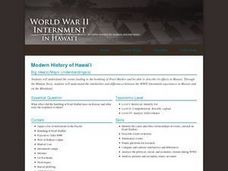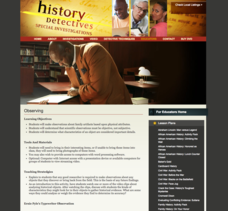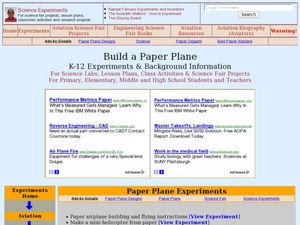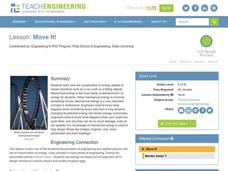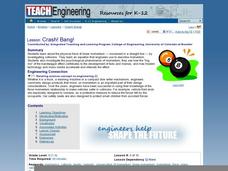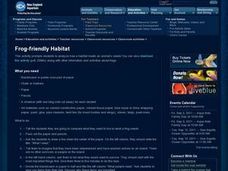Curated OER
Futuristic Flights
Students study the orbital space plane, NASA's proposed spacecraft of the future. They work in groups to plan missions to take place twenty years from now and design orbital space planes in which to carry out the missions.
Curated OER
Oxidation and Salt
Students study the reaction on iron in water, air, and sodium chloride. They create a situation that shows this process and gives them the opportunity to hypothesize what, why, and how. They keep records and do an oral and written ...
Curated OER
Weather Tools of the Trade
Fourth graders study the basic meteorological instruments (thermometer, barometer, weather vane, anemometer, and rain gauge). They explore how they are used, data that can be collected from them, and why records of the data are kept.
Curated OER
Building an Underwater Habitat
Students investigate underwater habitats. In this underwater habitat lesson, students study Aquarius and design their own underwater habitat that can sustain life. Students work in groups and present their habitats to the class. Students...
Curated OER
Rainforests of the Sea
In this ecology worksheet, students read and study about coral reefs using online resources to complete 8 short answer questions. They watch a video related to the topic.
Curated OER
Exploring Aerodynamics
Young scholars explore aerodynamics. In this aerodynamics instructional activity, students study the flight patterns of three paper airplanes and discover the underlying principles of aerodynamics. Resources and grade level modifications...
Curated OER
World War II: Modern History of Hawaii
Young scholars examine world geography by viewing a documentary film in class. In this World War II lesson, students discuss the role Hawaii played in the great battle and what type conflicts happened among the island chain. Young...
Curated OER
A Basin Filled With Time
Students use fossil leaves and a mathematical formula to study climate change. In this climate change and fossil lesson plan, students determine the differences in temperatures during two different times during the Cenozoic era using...
Curated OER
Birds on the Move
Learners observe the migrational path of the Swainson's Hawk from northern Minnesota to the southern portion of South America. They study the migratory path of the hawk and observe how the vegetation in a particular region of the earth...
Curated OER
Fieldwork: Horizons Under Ground: Digging Through Wetland Soil
Students study the different soil types and describe the different soils in various environments. In this soil lesson students walk to a reserve and discuss what they saw.
Curated OER
What Does the Inside of a Seed Look Like?
First graders study seeds. For this biology lesson, 1st graders observe the differences between dry and wet seeds and draw what is inside a seed after peeling off the outer coat of one of the seeds.
PBS
Observation
Students study making scientific observations . They conduct a "field study" in their attic and make observations about their family artifacts based upon physical attributes. In addition, they determine what characteristics of an object...
Curated OER
Properties of Water
Students study the three physical properties of water-solid, liquid and gas. They classify materials as solids, liquids, and gases. They define the terms solids, liquids and matter and explain that when materials are manipulated,...
Curated OER
Burning Issues
Students study fire management. In this science lesson, students recognize and understand what they think would be the most responsible and appropriate actions to take in regards to fire managment.
Curated OER
Thunder and Lightning
In this earth science activity, students read and study about the formation of lightning and thunder using online resources. They complete 8 short answer questions that follow.
Curated OER
Endangered Relationships
Young scholars study the interrelationship between the horseshoe crab and red knot. In this ecology lesson, students explain why several species became extinct. They research about endangered species found in their region.
Curated OER
Feeling Hot, Hot, Hot!
Students study the different types of volcanoes and how they erupt. In this volcano lesson students identify where volcanoes are most prevalent and options for predicting eruptions.
Curated OER
Build a Paper Plane
Students study the history of the paper plane. In this design lesson plan students create several types of paper planes and determine if there is a difference in mean flight distances.
Curated OER
Flash Flood!
Students study floods and flash floods. The About Floods page explains the difference between floods and flash floods, and why flash floods occur. The Flood Types page explores some of the different types of floods that occur. There is...
Curated OER
Earthquakes Rock!
Young scholars study the main methods to measure earthquakes; the Richter Scale and Mercalli Scale. They make a model of a seismograph and investigate which structural designs are most likely to survive an earthquake.
Curated OER
Move It!
Young scholars observe a demonstration presented by the teacher covering different types of energy. They participate in an experiment where they study numerous physics vocabulary words and visit websites that demonstrate examples of...
Curated OER
Crash! Bang!
Students study the physical force of linear momentum by investigating collisions. They analyze the difference between elastic and inelastic collisions. They calculate linear momentum.
Curated OER
Rain On
Fourth graders study the water cycle and clouds. In this water cycle and cloud lesson plan, 4th graders determine the definition of condensation and watch a demonstration in which the teacher makes a cloud in a bottle. They discuss the...
Curated OER
Frog Friendly Habitat
Students create a frog friendly habitat. For this animal habitat lesson, students study what animals need to survive and then create a frog habitat from a shoe box. Students write a report about frogs and present their habitats...






